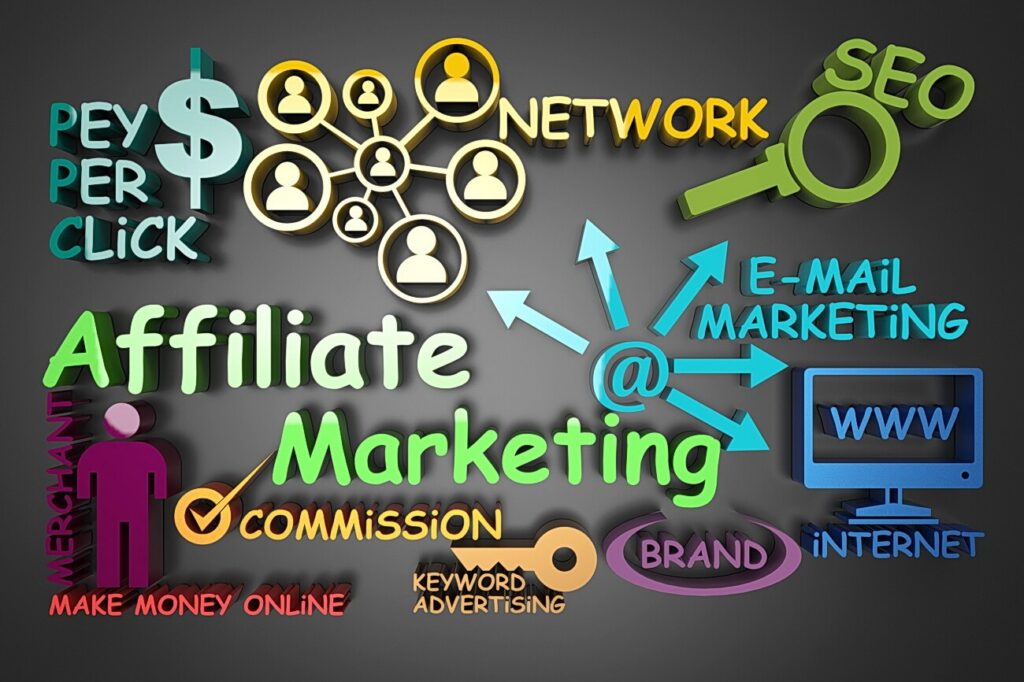Have you always dreamed of making money online? Would you like to work from home and earn money without creating your own products, no inventory, and – best of all – no customer service?
You are in the right place. I am here to help you unleash yourself and start the life you have always dreamed of. How? I’ll show you how to become an affiliate marketer.
According to Statista, affiliate marketing business spend in the US will reach $ 8.2 billion by 2022.
Affiliate marketing enables anyone to make money. Good money. You can make it at home or in a coffee shop. And yes, you can make money and generate passive income even while you sleep. But before that, there are a few things you need to know.
I’ve gathered the most popular questions beginner affiliates ask in one place, without worrying too much about how simple or obvious they might be. Buckle up.
I’m here to tell you from my own experience that affiliate marketing is a real business. The journey will not be easy and you will certainly not be an overnight success. But I can say that it is possible to be very successful with affiliate marketing.
This beginner’s guide will teach you how to get started with affiliate marketing. I wish I had something like this to help me through the process. So let’s get started!
Table of Contents
Why Become an Affiliate Marketer?
 What are many reasons to become an affiliate marketer?
What are many reasons to become an affiliate marketer?
- Passive income.
While any “regular” employment requires you to be present at work in order to earn money, affiliate marketing allows you to earn money while you sleep. By investing an initial amount of time in a campaign, you will continually win that time back as consumers purchase the product in the days and weeks that follow. You are paid for your effort long after it has been completed. Even if you are away from your computer, your marketing skills will bring you a steady income.
- No customer support.
Individual sellers and companies offering products or services need to interact with their consumers and ensure that they are satisfied with what they have bought.
You’ll never have to worry about customer service or happiness thanks to affiliate marketing’s framework. The affiliate marketer’s sole purpose is to connect the seller with the customer. The seller handles all consumer complaints after you receive your commission on the sale.
- Work from home.
If you hate going to the office, affiliate marketing is the perfect solution. You can run campaigns and generate income from the products sellers create while working from the comfort of your home. This is a job that you can do without ever taking off your pajamas.
- Inexpensive.
Most companies charge start-up fees as well as a cash flow to fund the products they sell Affiliate marketing, on the other hand, maybe done at a little cost, allowing you to get started quickly and with little work. There are no expenses to worry about with affiliate programs, and there is no need to manufacture a product. It’s quite simple to get started with this hobby.
- Convenient and flexible.
Since you will essentially become a freelancer, setting your own goals, redirecting your path when you feel like it, choosing the products that interest you, and even setting your own working hours, will provide the ultimate independence. This convenience means that you can diversify your portfolio as you wish or concentrate solely on simple and straightforward campaigns. You’ll also be free of company constraints and regulations, as well as underperforming teams.
- Performance-based rewards.
Other jobs allow you to work an 80-hour week and yet make the same amount of money. Affiliate marketing is solely reliant on your results. You get from what you put in it. Improving your review skills and writing engaging campaigns will lead to direct improvements in your sales. You are finally getting paid for your excellent work!
What Is Affiliate Marketing?
Affiliate marketing promotes other people’s products for a small commission on every sale. You have likely seen headlines saying “Affiliate Link” or “Sponsored Post” on many of the websites you visit, or perhaps you have already taken the first step and signed up for an affiliate network.
If you’re new to affiliate marketing, let’s discuss how it works.
First, find an affiliate program or network that you are interested in. View the program overview, including the type of products or services, payment methods, and commissions offered.
If it appeals to you, sign up and wait for confirmation of your approval. Then start creating content and adding the custom links that the program provides. These links keep track of when one of your users makes a purchase and you will earn a small commission.
You can work with specific companies or affiliate networks, registering and selecting the programs that appeal to you. To make it easier to choose, the programs are often grouped into categories. Once approved, start promoting your affiliate links on your website, in newsletters, on social media, and wherever you’re allowed to share links.
The network will send you a payment when you have reached the minimum payment level. PayPal, bank transfers, and cheques are the most common payment methods
How Much Money Can I Make As an Affiliate Marketer?
The short answer is that there is no limit. It depends on your niche and the amount of work you put into it. The most successful affiliate marketers make a six- or seven-digit month.
For example, Pat Flynn of Smart Passive Income earned over $ 100,000 in affiliate commissions in December 2017.
Larry Ludwig started an affiliate marketing blog “Investor Junkie” from scratch in December 2009 and sold it for $ 6 million in 2018. Another example is that Adam Enfroy made $ 812,718 in 2020. $601,698 was affiliate marketing passive income.
Another affiliate marketer, Ryan Robinson, reported over $19,000 in affiliate sales in October 2019. The Wirecutter, another successful affiliate website, had anticipated sales of $ 10 million before being acquired by the New York Times for $ 30 million.
Just remember, these people did an excellent job building their brand. It took you years of hard work to reach this level.
You have to manage your expectations. You won’t make big bucks right away, but don’t let it discourage you.
The success of others tells you that with hard work, time, and the right knowledge you can possibly reach this level too.
How Does Affiliate Marketing Work?
Affiliate marketing leverages the skills of a wide range of persons for a more successful marketing approach while also offering contributors a portion of the earnings since it divides the tasks of product marketing and product creation among the parties.
For this to work there must be three different parties involved:
- Salesperson and product developer.
- The partner or advertiser.
- The consumer.
Let’s dive into the complex relationship of these three parties to ensure that affiliate marketing is a success.
- Sellers and product developers.
The seller, whether a sole proprietor or a large corporation, is a vendor, distributor, product developer, or retailer who wants to bring a product to market. The product can be a physical item like housewares or a service like makeup tutorials.
The seller, often known as a brand, does not have to be actively participating in marketing, but can also be the advertiser and benefit from affiliate marketing’s revenue sharing.
For example, the seller could be an eCommerce retailer who started a dropshipping business and wants to reach new audiences by paying affiliate websites to promote their products. Alternatively, the seller could be a software as a service (SaaS) company that relies on affiliates to help sell its marketing tools.
- The partner or publisher.
Also known as a publisher, the affiliate can either be an individual or a company that markets the seller’s product in an engaging manner to potential consumers. In other words, the partner promotes the product in order to convince consumers that it is valuable or beneficial to them and to get them to buy the product. If the consumer buys the product in the end, the partner receives part of the sales achieved.
Affiliates frequently market to a highly specific audience and generally follow that audience’s interests. This creates a distinct niche or personal brand for the partner, allowing them to target customers who are most likely to respond to the promotion.
- The consumer.
Knowing or not, consumers (and their purchases) are the drivers of affiliate marketing. Affiliates spread the word about these products via social media, blogs, and websites.
When consumers buy the product, the seller and partner share the profit. Sometimes the affiliate chooses to be upfront with the consumer by disclosing that they will receive a commission on the sales they have made. At other times, the consumer may not be aware of the affiliate marketing infrastructure behind their purchase.
In either case, they will seldom pay more for the product purchased through affiliate marketing; the partner’s share of the profit is included in the sales price. The customer completes the purchase and receives the product, as usual, untouched by the affiliate marketing scheme in which he has a large stake.

How to Get Affiliate Links?
Affiliate links don’t just fall out of thin air.
You must acquire them by signing up for a merchant’s affiliate program. This program can exist directly with the merchant or in most cases through an affiliate network.
Merchants can give you links in two ways – either through an internal affiliate program or a network. The majority of affiliates work with merchants through an affiliate network.
Affiliate networks
A network affiliate program involves working with a third party to manage your relationship with the dealer. In general, an affiliate network manages communications, affiliate links, tracking, reporting, and payment.
Affiliate networks usually have thousands of merchants to choose from. You join the affiliate network and then apply for each individual merchant program. Some automatically approve applicants, while others review and approve new partners manually.
Once approved, you will have access to special affiliate links that are unique to you. These unique links can be placed anywhere you want to promote this retailer’s product. It may be on your blog, in an email, on your YouTube channel, or somewhere else entirely.
There are many affiliate networks and programs to choose from and one of the most popular is Amazon Associates. Their program is the largest affiliate marketing program in the world, with over a million registered employees.
Below I have listed some of the popular affiliate marketplaces that you can sign up with:
- Amazon Affiliate Program
- ClickBank
- ShareAsale
- Rakuten
- Awin
- Commission Junction
- ImpactRadius
- Digistore 24
Amazon products in particular are an easy way to get started. Many novices begin by becoming Amazon affiliates before moving on to more lucrative affiliate opportunities.
NOTE: It is always important to read the terms of your Affiliate Agreement before you begin promoting a dealer. Make sure you know where to put your affiliate links or not. For example, most merchants forbid you from bidding against their brand name or pretending to be the brand on Google Ads. Always check the restrictions before advertising; Otherwise, you can be blocked by the dealer.
- Affiliate networks have many advantages over in-house partner programs:
- They act as an intermediary between you and the dealer.
- They ensure that commissions are paid out on time.
- They allow you to work with thousands of traders from one dashboard.
- They serve as the merchant’s conversions checker to make sure things are on the rise.
- You can guarantee more accurate tracking of affiliate clicks and conversions.
- They offer you better reporting than internal partner programs.
In-house affiliate programs
You normally work considerably closely with the dealer and have a lot closer relationship with an in-house affiliate program.
Just like with affiliate networks, you will get affiliate links from the merchant’s affiliate program. The merchant is responsible for conversion tracking. Unfortunately, you have no way of knowing if a merchant is faking conversions and you rely on the merchant for on-time payments.
The advantages of an in-house relationship:
A closer relationship with the dealer
Usually higher payouts than available through public network affiliate programs
More flexible options to increase conversion rates
How Do You Track Affiliate Links?
With hundreds or maybe thousands of affiliate links on social media, your blog, and emails, it can be difficult to keep track of all of your affiliate links.
Many novice affiliate marketers take the URL links straight from a merchant and post them on their blog. Don’t make this mistake! You will regret it later when you have to exchange a link (which is common).
Instead, I recommend using link management software to cloak your affiliate links. Not only is it easier to manage, but it can also perform click analysis.
How Do Affiliate Marketers Get Paid?
Affiliate marketing is a simple and low-cost way to earn money without having to sell anything. It is clear for people who want to make more money online. But how is an affiliate paid after linking the seller with the consumer?
The answer can get complicated.
The consumer does not always have to buy the product for the partner to receive a kickback. Depending on the program, the affiliate’s contribution to the seller’s sales is rated differently.
The partner can be paid in several ways:
- Payment per sale.
This is the standard affiliate marketing structure. In this program, the retailer pays the affiliate a percentage of the sales price of the product after the consumer purchases the product based on the affiliate’s marketing strategies. In other words, the affiliate has to actually get the investor to invest in the product before being compensated.
- Pay per lead.
Pay-per-lead affiliate programs are a more complicated system that rewards affiliates based on lead conversion. The partner must convince the consumer to visit the retailer’s website and take the desired action – be it filling out a contact form, signing up for a product sample, subscribing to a newsletter or downloading software or files.
- Pay per click.
This program focuses on motivating the affiliate to redirect consumers from their marketing platform to the merchant’s website. This means that the partner must involve the consumer to the extent that he switches from the partner’s website to the retailer’s website. The affiliate is compensated based on the increased traffic to the website.
Most affiliate networks offer an electronic payment method – usually direct transfer or PayPal. On the other hand, direct relationships can only support direct deposits. Worse still, I’ve worked with some companies (high-tech firms, no less) that are still cutting back on physical controls.
How to Get Started With Affiliate Marketing
Now that we’ve got some basic information, let’s discuss the steps to get started as an affiliate marketer.

Choose your niche
The first – and most important – step in affiliate marketing is choosing your niche.
It is best to think about topics that interest you first. More importantly, your niche should be helpful. You want to be a problem solver as an entrepreneur. If you have a problem, chances are that others will as well!
You’re not starting a business to help yourself. You’re starting a business to help others.
Here are common mistakes businesses owners make. They think, “I’m going to start a business to get rich.” Yes, you can get rich, but that’s just the side benefit of helping others
Even I fell into this trap when I first started my blog Ambition Affiliate. The blog niche is how to make money online. Yes, I am interested in making money online and I know that many are struggling with this topic and need help. But my first blog posts were far from helpful. I’ve written about topics that interested me. The result? Nobody cared about it.
It wasn’t until I started writing articles to aid others that my site really took off.
Another common mistake is choosing a niche with no competition. I used to think that way too. I used to think that in order to be successful in business I had to come up with the most complicated business idea that no one else had thought of.
There is no such thing as a unique idea on the internet. If you thought about it, someone else has already done it.
The decisive factor is not how unique your idea is, but how well you implement it.
Pick a niche that is popular, but one that you believe offers growth opportunities. That’s exactly what I did with Investor Junkie.
If you think everything has been said about this niche and that there isn’t a unique angle on the topic or new features to add to a blog, then this market may be saturated. Maybe it’s not a good idea for a niche.
But I’ve found that sometimes the simplest ideas are the best.
Another common mistake is making the niche too wide. This is especially true when you’re first starting out.
Say you make kitchen utensils your nice one. It’s too broad a topic. Yes, the search volume is there, but it’s too big to rank for articles.
Instead, I would recommend registering a domain name that covers a broad topic but fits into one or possibly two specific niches to get started. You can always expand later.
Your topics will not help you with your audience or Google if they are all over the place.
Continuing with the previous example of kitchen utensils, I would narrow my niche down to two subjects – knives and cutting boards. They are not only very narrow but also complement each other.
Start a blog
Now that you’ve determined your niche, the next step is to create your blog. While it is possible to make money from affiliate marketing without a blog, I do not recommend it. You want your blog and organic search traffic to be the core affiliate marketing strategy.
Yes, it is possible to make money on YouTube or Pinterest, but you don’t own these channels.
You own a blog and are in control of it. You can only rent other channels, e.g. B. social media. You can be the hottest Instagram star since the Kardashians, but if Facebook decides it doesn’t like you anymore, your business can go away … overnight.
I’ve seen this happen to other affiliate marketers too many times. Build your company’s base on solid ground rather than quicksand.
Think of a blog as the hub of a bicycle. The hub is your blog. The spokes are channels like email, paid traffic, Facebook, Instagram, YouTube, push notifications, and the like. These channels are the means to attract visitors to your blog.
Create content
Since the core of your business is a blog, you want to create content on it. SEO (Search Engine Optimization) is the recommended method to get visitors to your blog. While you might want to create other ways of building an audience, organic search is still the primary method.
According to GrowthBadger’s research, most of the traffic to a website comes from organic search. Since Google is by far the # 1 search engine, you need to be found on Google. Yes, you can focus on social media, podcasts, and paid traffic, but if you don’t focus on SEO as a blogger, you are missing out on a huge audience.
For this step, I recommend creating at least 25 articles before moving on to the next step. These shouldn’t be short 200-word posts, but rather long, in-depth articles about your niche. If you find yourself in a weight loss niche, don’t write articles about your cat. Stay on your track and write about the niche you want to create.
You cannot skip this step. You need a website ready before you even think about applying for affiliate programs. If your blog has no content, not only do you have no audience, but you also stand little chance of getting approved by an affiliate manager.
So, before you start writing, plan out the 25 articles you want to write. Create Keystone Articles that you can easily rank for. If you can buy a keyword research tool like Ahrefs, I highly recommend it. A keyword research tool is invaluable.
And there are some free options.
Google Ads, Google Trends, and Google’s own search engine results are all excellent free resources for generating ideas for articles
Build your audience
Now it’s time to build your audience.
The most common method is organic search – also known as search engine optimization or SEO. Today, however, you have more options than ever:
- Youtube
- Podcast
- Quora
- Paid traffic
The list goes on and on.
Ideally, you want to build a fan base of returning visitors to your blog. Statistics show that it takes more than one touchpoint before a visitor converts. The data shows that it takes eight to twelve visits for a visitor to trust you enough.
Without question, SEO should be part of your audience-building strategy since 50-80% of all traffic to a blog comes from organic search.
Sign up for affiliate programs
Only after you have completed the first four steps should you proceed with this step. Applying for affiliate programs before you start your blog is similar to constructing a house before the concrete foundation is laid.
When you sign up for an affiliate program, you effectively become an “affiliate” in the merchant’s sales funnel. However, not all affiliate programs are the same.
The affiliate programs I recommend will allow you to sell any product or service through your blog.
Also, depending on your niche, you might want to consider signing up with dealers who are not some of the ones I recommend.
How do you know if a retailer has an affiliate program? Google “[brand-name] Affiliate” or “[brand-name] Affiliate Program”.
Many merchants do not advertise their affiliate programs. Instead of getting an influx of new partners, they prefer to keep it quiet. You need to contact these distributors directly and ask if they have an affiliate program.
I have also had great success reaching out to traders who don’t have affiliate programs and asking them if they would like to start one. However, I do not recommend this option unless you are a well-established player with clout in your niche.
Make Profit!
Your journey has only just begun. These are the basic steps to get started in affiliate marketing. Yes, there are many more elements that aren’t covered yet, but this is a good foundation to expand on as you go more skilled with affiliate marketing.
Conclusion
Affiliate marketing is a great alternative for people who want to be in charge of their own finances by focusing on performance-based revenue streams. By working with a salesperson, a motivated affiliate marketer can generate passive income from the comfort of their own home without having to worry about producing their own products or services.
Although the work’s success is dependent on the affiliate’s marketing skills, it can be an effective approach to reach your financial goals as a primary career or a profitable second job.



